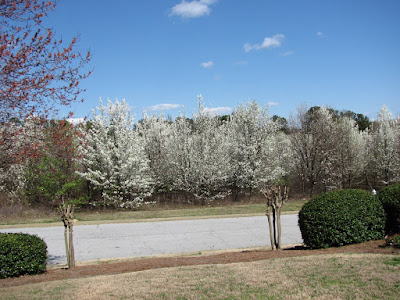One of the
most well-known flowering trees
is the Bradford Pear. They have
been
planted extensively by homeowners
and
landscapers for their rapid growth, beautiful pyramidal form, white spring flowers, and colorful
fall foliage. These trees have the
ability to grow in all types of
environmental conditions and are pest
resistant.
Bradford Pears
are beautiful trees with one serious flaw: they are very prone to limb breakage.
The trees have a rapid growth rate, weak wood,
and poor branch
structure
that becomes apparent when they are 10-20 years
old. The angle of the Bradford Pear’s
branches is quite
narrow. As they increase in
size,
the tree begins to
push itself apart.
Large sections of the canopy will collapse
under its
weight or parts
of the tree will break
off as
a result of wind,
rain, or ice. The broken branches can potentially fall on someone’s
house or car. Often,
many older
trees can
be observed missing sections of
their limbs
and trunk.
Bradford pear trees have branches that are prone to breaking
Another problem with Bradford pears is their
invasive tendencies. The trees produce small fruits with viable seeds. Birds consume
them and, along with the wind, disperse them throughout the area. Many places,
especially land that has been cleared in
recent years, is covered with the trees. The invasive ones sometimes have
thorns on them.
Bradford pear blossoms, though beautiful, can have an offensive odor. As the tree sheds them, the faded blooms can cover sidewalks, patios and vehicles that can be rather hard to clean.
Bradford pear blossoms, though beautiful, can have an offensive odor. As the tree sheds them, the faded blooms can cover sidewalks, patios and vehicles that can be rather hard to clean.
There are other
types of
flowering pear trees that do
not have as a serious problem of limb
breakage. Examples include
‘Aristocrat,’ ‘Chanticleer,’ ‘Select,’ or
‘Stonehill.’ One disadvantage to
the alternative varieties
is that some are susceptible
to a bacterial disease called
fire
blight, which causes the ends of the stems
and leaves to turn black,
become crisp, and curl.
There
is also
a wide variety of other attractive and
durable trees
for the landscape. For fast-growing alternatives,
consider using Chinese
Pistache (Pistacia chinensis) or Japanese Zelkova
(Zelkova serrulata) since both are sturdy, can grow in
difficult situations, are pest resistant and
have excellent
fall color. For spring flowering trees,
consider using alternatives
like
crabapples, serviceberries (Amelanchier)
or Fringe
Trees (Chionanthus).
Some of these trees
also produce ornamental
fruit and can grow 20-40 feet in
height. The
Crabapple variety ‘Callaway’
can tolerate the intense
heat and dryness of summers
in Georgia. Two
types of
Fringe Tree are
available:
the
American Fringe Tree has
a growth giving it an informal look while the Chinese Fringe Tree grows a more compact canopy. Both
of these trees have glossy leaves like the Bradford Pear.
The excessive use of
the
Bradford Pear has taught us a
valuable lesson.
Growing and
observing them in
a variety of environmental conditions
has helped us to understand the obvious disadvantages of a tree that
at first leaves an impression
of beauty.
 |
| In addition to having poor branch structure, Bradford pears also have invasive tendencies. (Photograph by Timothy Daly) |